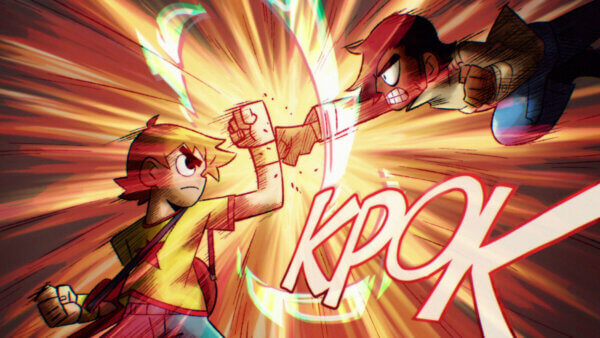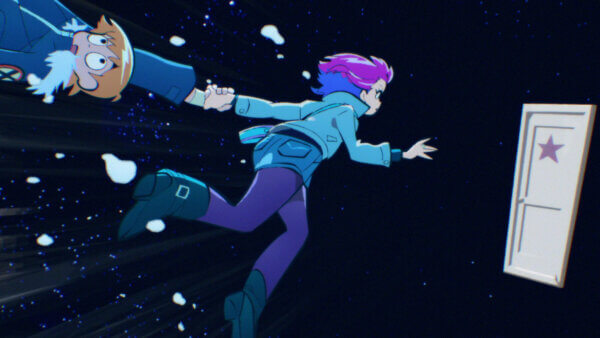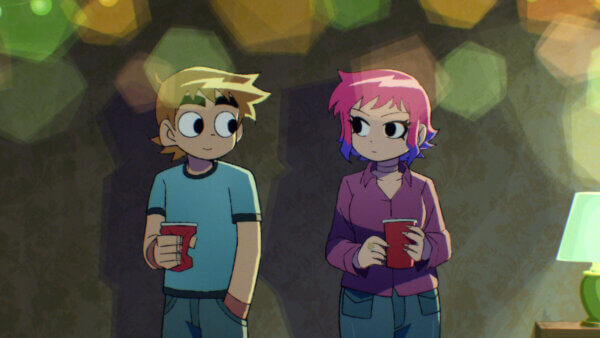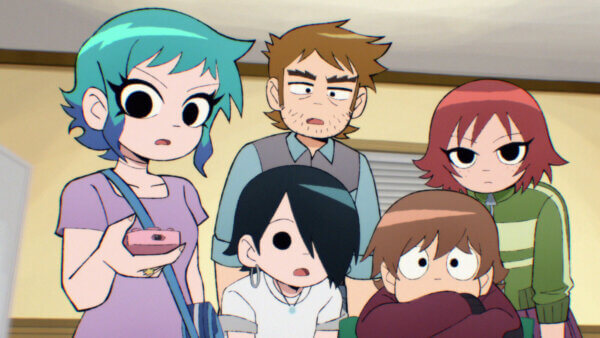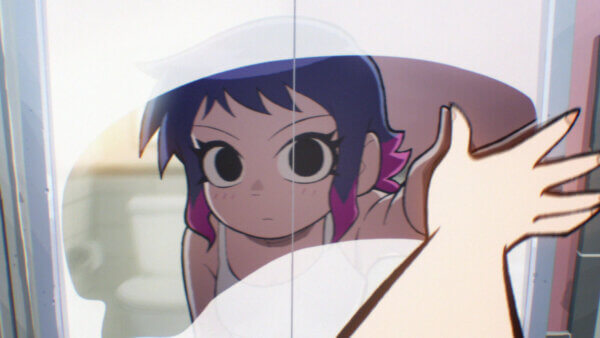Anime, Trauma & Regret: The Story of Scott Pilgrim Takes Off
“I feel like as I get older, regret just becomes part of the fabric of life, ” claimed Bryan Lee O’Malley in a 2014 interview with Slate. This statement helps form a picture of a man internally tunnelling through the caves of the past, analysing the curves and edges of the rock around him, pondering on how they could have been formed differently. In a way, the action we take in the present can at least project a different filter onto the past, providing a context that softens the sharp corners of those mistakes. Scott Pilgrim Takes Off is a mission to achieve just that.
Regret is found in the fabric of Takes Off through its subversions of its original story. We have mostly the same setup; Scott Pilgrim is a pretty shitty slacker guy in his early 20s who is dating a high schooler. The introduction of Ramona Flowers sees Scott fall head over heels before being forced to fight her seven evil exes to win her love. However, at the end of the first episode, Scott is removed from the spotlight entirely. The rest of the characters are left to analyse themselves and their choices in his absence, a representation of O’Malley and his collaborators looking for something new in this almost 20-year-old story.
“It’s a complete story from my 20s and early 30s and we’re exhuming the corpse, bringing it back to life and finding new things to do with it,” O’Malley tells Skwigly. “The addition of BenDavid [Grabinski] and Science SARU sparked new things for me that I would never have thought of on my own. And the animated medium allowed us to focus more on action and this magical, weightless feeling that animation can give you. Balancing that with the emotions that anime is so good at gives it new life.”
While Grabinski was fundamental to the writing process, Science SARU are responsible for injecting Scott Pilgrim Takes Off with fiery, colourful kineticism. The show is endlessly stunning, reinventing itself visually as the characters find new versions of themselves within the story. Adapting O’Malley’s comic art was something the original creator wanted to leave to the animation team. As he puts it himself, “When you hire Science SARU, you don’t tell them how to do it.”
Eunyoung Choi, president and CEO of Science SARU, was struck by the many shades of O’Malley’s comic, having only been familiar with Edgar Wright’s 2010 live-action adaptation before Netflix contacted them about Takes Off. “The comic stood out with its eclectic mix of humour, a true manga essence, and a video game-like feel, all set against the backdrop of Toronto,” Choi tells Skwigly. “We even visited Toronto to get a real feel of the place that inspired the comic.” There’s something ironic about a personal, specific story from a Canadian needing to travel across to Japan in order to find its home in the medium of animation, but Science SARU succeeded in making Takes Off feel like a natural evolution of Scott Pilgrim.
Much of that success is thanks to series director Abel Góngora, who was precise and detailed about translating 2D comic characters into animation. “We had long conversations with character designer Shuuhei Handa about the look of the characters,” Góngora explains. “He decided to carefully study the comics and adapted it for animation with his personal touch. The drawing style of Bryan evolves quite a lot in the comics, so I suggested to follow the last books, where the characters look maybe cleaner and closer to an animated look, but really it was Handa-sanʼs decision and taste at the end.
“As usual in these cases, we needed to find a more logical approach to the characters’ volume and three-dimensionality. The nose turning from a profile to a 3/4 view might have been the most challenging part, because it has a very 2D logic. It was Handa-sanʼs idea to have different hands for male and female characters and for the highlight in Ramonaʼs and Scottʼs hair to be different from the rest of the characters, shaped like lightning. I think this is a little bit different from the comics.”
Much like O’Malley and Grabinski’s dissatisfaction with a simple retelling of the familiar Scott Pilgrim legend, Abel was keen to reinvent how the show looked and to push the studio’s capabilities. We see action set pieces flow in and out of movies at a video rental, flashbacks with different aspect ratios and colour grading as well as an entire mockumentary episode changing the perspective of the camera.
But for Góngora, the most difficult sequence to execute was an elaborate, skateboarding escape from the show’s ninja-like paparazzi, “Fights in general require a lot of effort, but the skateboard sequences with Lucas [Lee] versus the paparazzi were very heavy because there were lots of characters and movements of those characters and backgrounds and effects like water and smoke. We mixed 3D and 2D to make it possible, something we had never done at this level before.”
O’Malley was keen to stress the autonomy of Science SARU, “I’m gonna have to keep explaining to people that I gave so few notes. I really didn’t tell them how to visualise it. What happened was we just wrote these scripts and I was very focused on that, on giving the characters life. Back in the day, when I was working on the comics, these characters felt very alive to me but for years they’ve been dormant. So my focus was on bringing back that feeling and bringing them back to life and having those themes tie into the tone of the world.
“It has to be from myself now. I can’t be myself 20 years ago, I don’t remember who that guy was. It naturally becomes this process of looking back at the old work, which represents my old self, and reconciling it with my current self and my current approach to work.” Bringing these characters back as an older, different person meant refracting them through a more emotionally mature prism, altering the decisions they make and getting closer to a true representation of who these characters are.
Removing Scott from the plot lets those more true representations shine in ways O’Malley wished they had in the original comics and in Edgar Wright’s film. In particular, Gideon gets more of a backstory with his more pathetic core being revealed under his brittle billionaire surface, but in the comics’ initial run, O’Malley had barely thought about the character before arriving at the final volume.
“I remember when we started the movie process, I met Jason Schwartzman. He asked to have lunch with me and talk about Gideon,” O’Malley recalls. “Gideon hadn’t even been in the books yet. I sat down with him and I realised I knew almost nothing about this character. I realised for the kinds of things that an actor would want to know about these characters, I had so little. That was a real eye opening. As a writer, it’s like, how do I get more inside these characters’ heads even the ones that are villains or that feel peripheral to me? Or feel so opposite from my viewpoint? I still have to understand them and get inside them.”
Much of that process of getting under the skin of these characters was born from a balance of creative control and collaboration. “With Edgar Wright’s movie, I was a tourist in that world. I had no idea how movies were made. I participated, I helped where I could, I worked in the art department, I gave script notes, I helped with casting, I was involved. But at the same time, it was not my project. So [Takes Off] got to be something that I was in charge of, which had never happened before, other than my solo project. I’d never been a boss before and I’d never been a collaborator with this many people at this level. The collaboration to me was the essence of it, and was the most beautiful thing about it.”
The agency felt by O’Malley in creating the story is reflected by the enhanced role of Ramona in it. During the comics’ initial run and even more so in the aftermath of the film, Ramona’s character was saddled with the label of the archetypal “Manic Pixie Dream Girl,” a character without an inner life, a pretty face existing only to give sage wisdom to a male main character. The way in which that male protagonist is removed from Takes Off is a very pointed subversion of what people know that character to be.
“It’s been around for a long time, people have formed lots of different opinions. I’ve seen completely polar opposite readings of what it all means so it was fun to play with that aspect as well, to corral the fan response and the legacy of the series into [Takes Off] itself was very appealing to me,” says O’Malley. “Not necessarily overtly commenting or responding to anything, but just to kind of poke at the characters and find new avenues to them or try the opposite of what a character was and see how that plays.”
Even if not intended as a direct response, that particular change makes Scott Pilgrim Takes Off a more appealing story to a new generation of potential fans who are looking for more depth to their stories, who want something without well-trod tropes that can feel like relics of a past era of storytelling. Though Takes Off remains a mid-2000s story, existing in, as O’Malley describes it, “a pocket dimension of Scott-Pilgrim-time,” it tactfully removes the sharp-edged prejudices that were normalised at the time and appear in both O’Malley’s comics and Wright’s film.
“We’re trying to make it speak to everyone from my age, on down to teenagers who have never necessarily seen it before. The goal was to create something layered enough that you could experience it completely cold and still get an entertaining story and the information is all layered in,” states O’Malley. “But also, if you’re familiar with the books and the movie, then it adds a whole different layer for you and those scenes really hit in a different way. If you’re deeply familiar, or if you’ve been reading it for a year or 10 or 20 years, it’s in you at some point and hopefully this show can tap into that. That’s kind of been my dream.”
Through Takes Off, the Scott Pilgrim story achieves wider appeal, not by sanitising itself but by ploughing deeper emotions for every character involved. Despite there being plenty to enjoy from the comics and film, if you didn’t see yourself in Scott, there are few other characters with complete personalities for you to invest in. Scott Pilgrim Takes Off is a display of an entire spectrum of emotions, lives and stories all bound together by the universality of anime, trauma and regret.
Scott Pilgrim Takes Off is available now on Netflix


